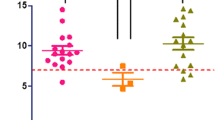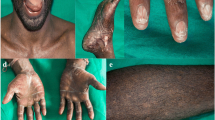Abstract.
Dyskeratosis congenita is an inherited skin and bone marrow failure syndrome. There are X-linked, autosomal dominant and autosomal recessive forms of the disease. The X-linked form is due to mutations in the DKC1 gene at Xq28. The encoded protein, dyskerin, is a component of both small nucleolar ribonuclear protein particles and the telomerase complex. Mutations in DKC1 mainly lead to amino acid substitutions. The autosomal dominant form of the disease is due to mutations in hTR, the RNA component of telomerase, making it likely that the disease is due to defective telomerase activity. Mutations in hTR are predicted to either disrupt secondary structure or alter the template region. The gene or genes involved in the recessive forms of the disease remain elusive, though genes whose products are required for telomere maintenance are strong candidates.
Similar content being viewed by others
Author information
Authors and Affiliations
Additional information
Received 26 July 2002; received after revision 27 August 2002; accepted 28 August 2002
RID="*"
ID="*"Corresponding author.
Rights and permissions
About this article
Cite this article
Marrone, A., Mason, P. Human Genome and Diseases:¶Dyskeratosis congenita. CMLS, Cell. Mol. Life Sci. 60, 507–517 (2003). https://doi.org/10.1007/s000180300042
Issue Date:
DOI: https://doi.org/10.1007/s000180300042




